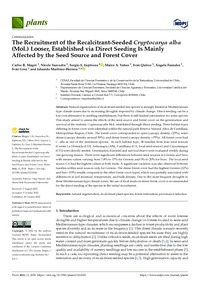Mostrar el registro sencillo de la publicación
The recruitment of the recalcitrant-seeded cryptocarya alba (mol.) looser, established via direct seeding is mainly affected by the seed source and forest cover
| dc.contributor.author | Magni, Carlos R. | |
| dc.contributor.author | Saavedra, Nicole | |
| dc.contributor.author | Espinoza, Sergio E | |
| dc.contributor.author | Yáñez, Marco A | |
| dc.contributor.author | Quiroz, Iván A. | |
| dc.contributor.author | Faúndez, Ángela | |
| dc.contributor.author | Grez, Iván | |
| dc.contributor.author | Martínez-Herrera, Eduardo | |
| dc.date.accessioned | 2022-12-14T17:27:16Z | |
| dc.date.available | 2022-12-14T17:27:16Z | |
| dc.date.issued | 2022 | |
| dc.identifier.uri | http://repositorio.ucm.cl/handle/ucm/4217 | |
| dc.description.abstract | Natural regeneration of recalcitrant-seeded tree species is strongly limited in Mediterraneantype climate zones due to increasing droughts imposed by climate change. Direct seeding can be a low-cost alternative to seedling establishment, but there is still limited information for some species. This study aimed to assess the effects of the seed source and forest cover on the germination and survival of the endemic Cryptocarya alba Mol. established through direct seeding. Three habitat types differing in forest cover were identified within the natural park Reserva Natural Altos de Cantillana, Metropolitan Region, Chile. The forest cover corresponded to open (canopy density <25%), semidense (canopy density around 50%), and dense forest (canopy density >75%). All forest cover had C. alba as one of the dominant species. At each habitat type, 38 families from four seed sources (Cuesta La Dormida (CD), Antumapu (AN), Cantillana (CA, local seed source) and Cayumanque (CY)) were directly seeded. Germination (Germin) and survival (Surv) were evaluated weekly during one growing season. There were significant differences between seed sources in Germin and Surv, with means values varying from 7.8% to 37% for Germin and 0% to 20% for Surv. The local seed source CA had the highest values in both traits. A significant variation was also observed between families within seed sources only for Germin. The dense forest cover had the highest Germin (22%) and Surv (55%) results compared to the other forest cover types, which was partially associated with differences in soil moisture, temperature, and bulk density. Due to the most frequent droughts in these Mediterranean-type climate zones, the use of local seeds on dense forest cover is recommended for the direct seeding of the species in the initial recruitment. | es_CL |
| dc.language.iso | en | es_CL |
| dc.rights | Atribución-NoComercial-SinDerivadas 3.0 Chile | * |
| dc.rights.uri | http://creativecommons.org/licenses/by-nc-nd/3.0/cl/ | * |
| dc.source | Plants, 11(21), 2918 | es_CL |
| dc.subject | Natural regeneration | es_CL |
| dc.subject | Recalcitrant plant species | es_CL |
| dc.subject | Forest restoration | es_CL |
| dc.subject | Provenance selection | es_CL |
| dc.title | The recruitment of the recalcitrant-seeded cryptocarya alba (mol.) looser, established via direct seeding is mainly affected by the seed source and forest cover | es_CL |
| dc.type | Article | es_CL |
| dc.ucm.facultad | Facultad de Ciencias Agrarias y Forestales | es_CL |
| dc.ucm.indexacion | Scopus | es_CL |
| dc.ucm.indexacion | Isi | es_CL |
| dc.ucm.uri | mdpi.com/2223-7747/11/21/2918 | es_CL |
| dc.ucm.doi | doi.org/10.3390/plants11212918 | es_CL |



